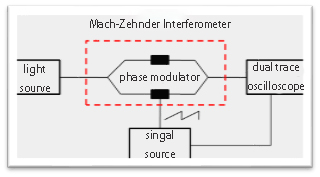A comprehensive understanding of electro-optic modulators
An Electro-optic modulator (EOM) is an electro-optic converter that uses electrical signals to control optical signals, mainly used in the optical signal conversion process in the field of telecommunications technology.
The following is a detailed introduction to the electro-optic modulator:
1. The basic principle of the electro-optic modulator is based on the electro-optic effect, that is, the refractive index of some materials will change under the action of an applied electric field. As light waves pass through these crystals, the propagation characteristics change with the electric field. Using this principle, the phase, amplitude or polarization state of the optical signal can be controlled by changing the applied electric field.
2. Structure and composition Electro-optical modulators are generally composed of optical paths, amplifiers, filters and photoelectric converters. In addition, it includes key components such as high-speed drivers, optical fibers and piezoelectric crystals. The structure of the electro-optic modulator can vary according to its modulation mode and application requirements, but usually includes two parts: electro-optic inverter module and photoelectric modulation module.
3. Modulation mode Electro-optic modulator has two main modulation modes: phase modulation and intensity modulation. Phase modulation: The phase of the carrier changes as the modulated signal changes. In the Pockels electro-optic modulator, carrier-frequency light passes through a piezoelectric crystal, and when a modulated voltage is applied, an electric field is generated in the piezoelectric crystal, causing its refractive index to change, thus changing the phase of the light. Intensity modulation: The intensity (light intensity) of the optical carrier changes as the modulated signal changes. Intensity modulation is usually achieved using a Mach-Zehnder intensity modulator, which is equivalent in principle to a Mach-Zehnder interferometer. After the two beams are modulated by the phase shifting arm with different intensities, they are finally interfered with to get the intensity modulated optical signal.
4. Application areas Electro-optical modulators have a wide range of applications in a number of fields, including but not limited to: optical communication: In high-speed optical communication systems, electro-optical modulators are used to convert electronic signals into optical signals to achieve data encoding and transmission. By modulating the intensity or phase of the optical signal, the functions of light switching, modulation rate control and signal modulation can be realized. Spectroscopy: Electro-optical modulators can be used as components of optical spectrum analyzers for spectral analysis and measurement. Technical measurement: electro-optical modulators also play an important role in radar systems, medical diagnostics and other fields. For example, in radar systems, it can be used for signal modulation and demodulation; In medical diagnosis, it can be used for optical imaging and therapy. New photoelectric devices: electro-optical modulators can also be used to manufacture new photoelectric devices, such as electro-optical switches, optical isolators, etc.
5. Advantages and disadvantages Electro-optic modulator has many advantages, such as high reliability, low power consumption, easy installation, small size and so on. At the same time, it also has good electrical characteristics and anti-interference ability, which can be used for broadband transmission and a variety of signal processing needs. However, the electro-optic modulator also has some shortcomings, such as signal transmission delay, easy to be interfered by external electromagnetic waves. Therefore, when using the electro-optic modulator, it is necessary to choose the right product according to the actual application needs to achieve good modulation effect and performance. In summary, the electro-optic modulator is an important electro-optic converter, which has a wide application prospect in many fields such as optical communication, spectroscopy and technical measurement.
With the continuous progress of science and technology and the increasing demand for high-performance optical devices, electro-optical modulators will be more widely developed and applied.

Post time: Nov-18-2024





